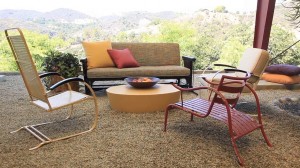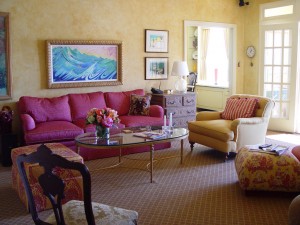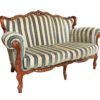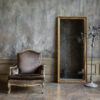There is no doubt that your interior design needs to be, above anything else, practical and convenient. Certain elements of it, however, can be freely modified according to your aesthetic preferences and personal taste, without affecting the efficiency and comfort of your home. Actually, it is precisely the small details and fine touches that allow you to create the cozy and charming atmosphere that you have always wanted for your home. Impressive curtains, artistic area rugs, interesting light fixtures and other similar features can make your place unique and special, a true reflection of your personality and your lifestyle.
Upholstery is one of these interior elements that allow for lots of flexibility and creativity on your part. It comes in a great variety of styles, colors and materials and adds to the comfort and great looks of your cherished furniture. High quality upholstery can considerably enhance the value of a piece, whereas tattered or worn upholstery can ruin a furniture item and diminish the overall appeal of your home. Therefore, it is highly advisable to keep your upholstered pieces in good condition and have them properly reupholstered when they start to show signs of wear and tear. But what is the best upholstery material? What upholstery fabric to choose?
There are plenty of upholstery options to choose from, so you need to get familiar with their distinctive features in order to make an informed decision for your furniture.
Things to Consider When Choosing Upholstery Materials

If you want to have a superior piece of furniture that can stand the test of time, you need high quality upholstery that resists wear and abrasion.
When choosing the right upholstery for your furniture, you should take into consideration the fabric quality and type, as well as the color, pattern, and style that will best match your preferences and the rest of your home décor.
Durability
If you want to have a superior piece of furniture that can stand the test of time, you need high quality upholstery that resists wear and abrasion. The thread count (the number of threads per square inch of fabric) is the key factor to consider when it comes to durability – a high thread count means that the fabric is tightly woven and highly resistant to wear.
So, when shopping around for durable upholstery materials, have in mind that:
- denser fabric lasts longer;
- heavy fabrics are more durable than lightweight ones;
- woven patterns hold up better than printed ones;
- a higher cost does not mean a more durable material – oftentimes, the most expensive upholsteries (such as silk, for example) are very vulnerable to wear and tear because they are extremely delicate. Lower-cost and lower-grade fabrics may be much more durable.
Different types of finishes (water-repellent, soil-repellent, fire-retardant, antibacterial, etc.) are commonly applied to fabrics and fibers to enhance their durability.
Ease of Maintenance
Once again, fabrics with higher thread count have a definite advantage – they are more likely to resist dirt and stains as tightly woven fabrics keep liquid spills on the surface and make cleaning much easier.
Many upholstery fabrics can be machine-washed – just make sure you use cold water and a mild detergent and tumble dry on the lowest heat for 5-15 minutes when machine washing upholstery. It is a good idea to put the covers back on the cushions while they’re still damp to prevent shrinking.
Upholsteries that are not machine-washable need to be vacuumed on a regular basis. They can be spot cleaned with a mild, water-free solvent or dry cleaning product. Needless to say, any spills should be blotted up immediately.
Good to remember: Position your upholstered furniture out of direct sunlight to prevent fading and cracking (for leather upholstery).
Style
Each fabric has its own style and character. You should pick the one that appeals to you the most, of course, but you also need to make sure that it will look good in your home. Have in mind that:
- the upholstery you choose should match the design of the furniture piece it is covering (a traditional fabric will look better on a traditional frame and vice versa);
- the fabric you are going to use for your furniture should echo the style that you have established throughout your home (some fabrics appear casual, others look more formal, etc.);
- the scale of the pattern should be appropriate to the size of the furniture it is intended for, as well as to the size of the room where the piece is located (a large pattern will look better in a larger room, while a smaller one will be the better choice for smaller spaces).
Color

Color is often the biggest factor when choosing new upholstery for your furniture.
Color is often the biggest factor when choosing new upholstery for your furniture. It is generally recommendable to opt for neutral colors and patterns – they look good in different settings and can be combined with various accessories and designer styles. Here are a few guidelines you may want to consider when choosing the color of your new upholstery:
- Avoid vivid colors for smaller rooms, especially if your furniture is large;
- If you have set your mind on bold patterns, at least make sure you choose smaller ones;
- If you select a neutral color, dress it up with colorful accents – patterned pillows or intensely hued throw blankets;
- Upholstery that’s similar in color to the walls and curtains will give your room a calm, cohesive feel, while a contrasting color will result in a modern, impressive look;
- Avoid delicately colored fabrics if you have young children and/or pets;
- Avoid trendy colors unless they perfectly match your home decor. Have in mind that fashion trends change quickly – what’s fancy today won’t be considered fancy in a couple of years.
If you are not sure what color will work best for your home, you can order two or three fabric swatches to get a realistic idea of how the furniture item will actually look in your particular surroundings. You can get free swatches from stores that sell quality upholstered pieces (some stores may request a deposit on the swatch, but they will refund it when you return the fabric). If possible, keep the swatch for several days to see how it looks in different kinds of light and to make sure that you truly love that specific color and style.
Pets
If you have pets, avoid using delicate or heavily textured fabrics. It is a good idea to go for leather or microfiber, as they are considered to be the most pet-friendly upholsteries available on the market. Both materials are very easy to clean and maintain. Besides, your pets’ claws won’t get caught in them, as there are no loops in the fabric.
SEE ALSO: How to repair furniture damaged by pets
Other Useful Considerations
- Allergies – if a member of your family suffers from allergy symptoms, make sure you opt for fabrics that are lint free and don’t attract dust;
- Mildew – if you live in a humid climate, mildew resistant fabrics will be your best option;
- Fading – if your upholstered furniture will be placed in a room that gets plenty of sunlight or if it will be placed near a window, you should go for fade resistant fabrics.
Upholstery Options

Therefore, leather upholstery not only looks sophisticated and luxurious, but also requires minimal maintenance.
Having taken all the above considerations into account, you can choose the upholstery option that’s right for you:
- Leather – leather is a very popular choice among modern day homeowners because of its high practical and aesthetic value. It is a natural fabric that is very durable and highly resistant to spills and stains. Therefore, leather upholstery not only looks sophisticated and luxurious, but also requires minimal maintenance. It ages well over time and adds to the character of a piece. Faux leather has also been gaining ground in recent years – it combines the stunning look of natural leather with the various benefits of synthetic materials;
- Wool – wool is a highly versatile natural fiber that comes in a great variety of textures and patterns. Wool’s curly fibers create loft and resiliency, making wool upholstery very durable and resistant to abrasions. It is easy to clean and maintain and retains its beauty for many years;
- Cotton and cotton blends – comfortable, durable, and easy to maintain, cotton is a great upholstery choice for heavily used furniture. Cotton fibers are soft and pliable, making cotton upholstery resistant to pilling (lumps of fiber on the fabric surface). What’s more, cotton resists sun damage very well and accepts brilliant dye, so cotton upholsteries come in a wide range of colors and styles. If you need an elegant and family-friendly solution for your furniture upholstery, consider a durable twill cotton slipcover that allows easy removal and cleaning. You can also choose from a number of high-quality cotton blends that are very sturdy and resistant to staining – chintz, chenille, gingham, etc.;
- Linen – linen is the oldest known fabric. It is a casual, breathable material, made from flax. Linen upholstery is elegant and durable and can last for a long time when kept away from direct sunlight (linen weakens in the sun). It comes in an array of color options and offers a textured look that’s both elegant and relaxed;
- Polyester – generally used in cotton and linen blends, polyester is both functional and stylish – it is durable, resistant to stains and pulling, and requires very little maintenance. The colors are vibrant and fade-resistant, adding to the charm and coziness of your home décor. Polyester upholstery provides the great look and feel of cotton or linen at a much more affordable price;
- Microsuede – microsuede is a type of microfiber (material made of fibers smaller than 1 denier, which makes them thinner than silk) designed to have qualities similar to suede. It is a durable material that’s still very comfortable and soft to the touch. Microsuede upholstery is available in a variety of colors and styles and offers a charming casual look. The fabric features a tight weave that’s resistant to spills and soiling, which makes it very suitable for everyday use;
- Silk – silk is an extremely delicate and luxurious material that can be crafted into a variety of textiles – burlap, brocade, velvet, etc. Silk upholstery looks stunningly beautiful and elegant, but it doesn’t stand up to abrasion, ultraviolet light, moisture, and heavy daily use. Synthetic silks offer a more practical solution for the busy home environment;
- Vinyl – affordable, durable, and easy to maintain, vinyl has become a popular upholstery choice during the last several decades;
- Acrylic – acrylic is commonly used as an alternative to wool. It is a good-looking material that can resist pilling, wear, and stains.
Whatever material you choose, have in mind that furniture reupholstering requires professional knowledge, specialized equipment, and excellent skills. Make sure you choose a qualified and experienced furniture restoration specialist to complete your furniture reupholstering project and bring new life to your worn out pieces. The experts can restore the original beauty of your furniture or create an entirely new look to match your aesthetic preferences and designer visions. Your home will become just as comfortable, cozy, and appealing as you’ve always wanted it to be!












